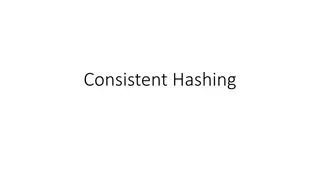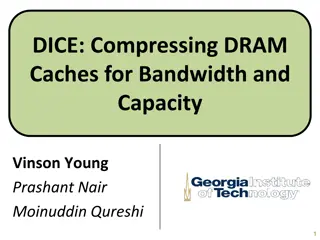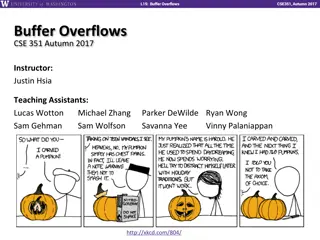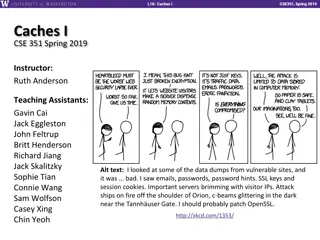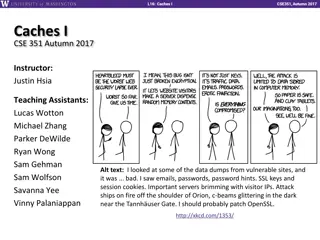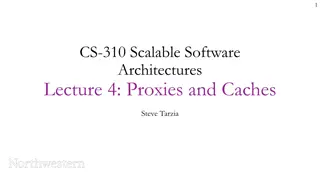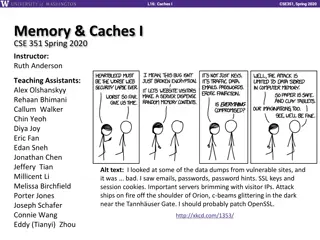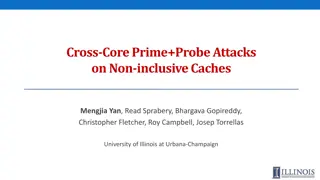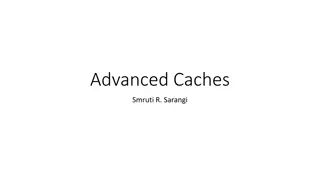
Understanding Caches III in CSE351 Winter 2019
Explore the concepts of caches in CSE351 Winter 2019, including cache basics, memory hierarchies, cache organization, and handling writes for fast memory accesses. Dive into direct-mapped caches, CPU address requests, and solving problems with cache conflicts.
Download Presentation

Please find below an Image/Link to download the presentation.
The content on the website is provided AS IS for your information and personal use only. It may not be sold, licensed, or shared on other websites without obtaining consent from the author. If you encounter any issues during the download, it is possible that the publisher has removed the file from their server.
You are allowed to download the files provided on this website for personal or commercial use, subject to the condition that they are used lawfully. All files are the property of their respective owners.
The content on the website is provided AS IS for your information and personal use only. It may not be sold, licensed, or shared on other websites without obtaining consent from the author.
E N D
Presentation Transcript
L18: Caches III CSE351, Winter 2019 Caches III CSE 351 Winter 2019 Instructors: Max Willsey Luis Ceze Teaching Assistants: Britt Henderson Lukas Joswiak Josie Lee Wei Lin Daniel Snitkovsky Luis Vega Kory Watson Ivy Yu https://what-if.xkcd.com/111/
L18: Caches III CSE351, Winter 2019 Administrivia Lab 3 due today (Friday) Lab 4 out this weekend HW 4 is released, due next Friday (03/01) Last day for regrade requests! Extra OH today Me 12:00-1:30pm CSE 280 Lukas 2:30pm-close 2nd floor breakout Cache sim! 2
L18: Caches III CSE351, Winter 2019 Making memory accesses fast! Cache basics Principle of locality Memory hierarchies Cache organization Direct-mapped (sets; index + tag) Associativity (ways) Replacement policy Handling writes Program optimizations that consider caches 3
L18: Caches III CSE351, Winter 2019 Checking for a Requested Address CPU sends address request for chunk of data Address and requested data are not the same thing! Analogy: your friend his or her phone number TIO address breakdown: ?-bit address: Tag (?) Index (?) Offset (?) Block Number Index field tells you where to look in cache Tag field lets you check that data is the block you want Offset field selects specified start byte within block Note:? and ? sizes will change based on hash function 4
L18: Caches III CSE351, Winter 2019 Direct-Mapped Cache Memory Cache Block Addr 0000 0001 0010 0011 0100 0101 0110 0111 1000 1001 1010 1011 1100 1101 1110 1111 Block Data Index 00 01 10 11 Tag 00 11 01 01 Block Data Here ? = 4 B and ?/? = 4 Hash function: index bits Each memory address maps to exactly one index in the cache Fast (and simpler) to find an address 5
L18: Caches III CSE351, Winter 2019 Direct-Mapped Cache Problem Memory Cache Block Addr 0000 0001 0010 0011 0100 0101 0110 0111 1000 1001 1010 1011 1100 1101 1110 1111 Block Data Index 00 01 10 11 Tag ?? ?? Block Data Here ? = 4 B and ?/? = 4 ?? What happens if we access the following addresses? 8, 24, 8, 24, 8, ? Conflict in cache (misses!) Rest of cache goes unused Solution? 6
L18: Caches III CSE351, Winter 2019 Associativity What if we could store data in any place in the cache? More complicated hardware = more power consumed, slower So we combine the two ideas: Each address maps to exactly one set Each set can store block in more than one way 1-way: 8 sets, 1 block each 2-way: 4 sets, 2 blocks each 4-way: 2 sets, 4 blocks each 8-way: 1 set, 8 blocks Set Set Set 0 1 2 3 4 5 6 7 0 0 1 0 2 1 3 direct mapped fully associative 7
L18: Caches III CSE351, Winter 2019 Note: The textbook uses b for offset bits Cache Organization (3) Associativity (?): # of ways for each set Such a cache is called an ?-way set associative cache We now index into cache sets, of which there are ? = ?/?/? Use lowest log2?/?/? = ? bits of block address Direct-mapped: ? = 1, so ? = log2?/? as we saw previously Fully associative: ? = ?/?, so ? = 0 bits Used for tag comparison Selects the set Selects the byte from block Tag (?) Index (?) Offset (?) Increasing associativity Decreasing associativity Fully associative (only one set) Direct mapped (only one way) 8
L18: Caches III CSE351, Winter 2019 block size: capacity: address: 16 B 8 blocks 16 bits Example Placement Where would data from address 0x1833 be placed? Binary: 0b 0001 1000 0011 0011 ? = ? ? ? ? = log2?/?/? ? = log2? ?-bit address: Tag (?) Index (?) Offset (?) ? = ? ? = ? ? = ? 2-way set associative Direct-mapped 4-way set associative Set Tag Data Set Tag Data Set Tag 0 1 2 3 4 5 6 7 Data 0 0 1 2 1 3 9
L18: Caches III CSE351, Winter 2019 Block Replacement Any empty block in the correct set may be used to store block If there are no empty blocks, which one should we replace? No choice for direct-mapped caches Caches typically use something close to least recently used (LRU) (hardware usually implements not most recently used ) 2-way set associative Direct-mapped 4-way set associative Set Tag Data Set Tag Data Set Tag 0 1 2 3 4 5 6 7 Data 0 0 1 2 1 3 10
L18: Caches III CSE351, Winter 2019 Peer Instruction Question We have a cache of size 2 KiB with block size of 128 B. If our cache has 2 sets, what is its associativity? A. 2 B. 4 C. 8 D. 16 E. We re lost If addresses are 16 bits wide, how wide is the Tag field? 11
L18: Caches III CSE351, Winter 2019 General Cache Organization (?, ?, ?) ? = blocks/lines per set set line (block plus management bits) ? = # sets = 2? Cache size: ? = ? ? ? data bytes (doesn t include V or Tag) V Tag 0 1 2 K-1 valid bit ? = bytes per block 12
L18: Caches III CSE351, Winter 2019 Notation Review We just introduced a lot of new variable names! Please be mindful of block size notation when you look at past exam questions or are watching videos Variable This Quarter Formulas Block size ? (? in book) Cache size ? ? = 2? ? = 2? ? = 2? ? = log2? ? = log2? ? = log2? Associativity ? Number of Sets ? Address space ? ? = ? ? ? ? = log2?/?/? ? = ? + ? + ? Address width ? Tag field width ? Index field width ? Offset field width ? (? in book) 13
L18: Caches III CSE351, Winter 2019 Example Cache Parameters Problem 4 KiB address space, 125 cycles to go to memory. Fill in the following table: Cache Size Block Size Associativity Hit Time Miss Rate Tag Bits Index Bits Offset Bits 256 B 32 B 2-way 3 cycles 20% AMAT 14
L18: Caches III CSE351, Winter 2019 1) Locate set 2) Check if any line in set is valid and has matching tag: hit 3) Locate data starting at offset Cache Read ? = blocks/lines per set Address of byte in memory: ? bits ? bits ? bits ? = # sets = 2? set index block offset tag data begins at this offset v tag 0 1 2 K-1 valid bit ? = bytes per block 15
L18: Caches III CSE351, Winter 2019 Example: Direct-Mapped Cache (? = 1) Direct-mapped: One line per set Block Size ? = 8 B Address of int: v tag 0 1 2 3 4 5 6 7 ? bits 0 01 100 v tag 0 1 2 3 4 5 6 7 find set ? = 2? sets v tag 0 1 2 3 4 5 6 7 v tag 0 1 2 3 4 5 6 7 16
L18: Caches III CSE351, Winter 2019 Example: Direct-Mapped Cache (? = 1) Direct-mapped: One line per set Block Size ? = 8 B Address of int: valid? + match?: yes = hit ? bits 0 01 100 v tag 0 1 2 3 4 5 6 7 block offset 17
L18: Caches III CSE351, Winter 2019 Example: Direct-Mapped Cache (? = 1) Direct-mapped: One line per set Block Size ? = 8 B Address of int: valid? + match?: yes = hit ? bits 0 01 100 v tag 0 1 2 3 4 5 6 7 block offset int (4 B) is here This is why we want alignment! No match? Then old line gets evicted and replaced 18
L18: Caches III CSE351, Winter 2019 Example: Set-Associative Cache (? = 2) 2-way: Two lines per set Block Size ? = 8 B Address of short int: ? bits 0 01 100 v tag 0 1 2 3 4 5 6 7 v tag 0 1 2 3 4 5 6 7 find set v tag 0 1 2 3 4 5 6 7 v tag 0 1 2 3 4 5 6 7 v tag 0 1 2 3 4 5 6 7 v tag 0 1 2 3 4 5 6 7 v tag 0 1 2 3 4 5 6 7 v tag 0 1 2 3 4 5 6 7 19
L18: Caches III CSE351, Winter 2019 Example: Set-Associative Cache (? = 2) 2-way: Two lines per set Block Size ? = 8 B Address of short int: ? bits 0 01 100 compare both valid? + match: yes = hit tag tag v 0 1 2 3 4 5 6 7 v tag 0 1 2 3 4 5 6 7 block offset 20
L18: Caches III CSE351, Winter 2019 Example: Set-Associative Cache (? = 2) 2-way: Two lines per set Block Size ? = 8 B Address of short int: ? bits 0 01 100 compare both valid? + match: yes = hit v tag 0 1 2 3 4 5 6 7 v tag 0 1 2 3 4 5 6 7 block offset short int (2 B) is here No match? One line in set is selected for eviction and replacement Replacement policies: random, least recently used (LRU), 21
L18: Caches III CSE351, Winter 2019 Types of Cache Misses: 3 C s! Compulsory (cold) miss Occurs on first access to a block Conflict miss Conflict misses occur when the cache is large enough, but multiple data objects all map to the same slot e.g. referencing blocks 0, 8, 0, 8, ... could miss every time Direct-mapped caches have more conflict misses than ?-way set-associative (where ? > 1) Note:Fully-associative only has Compulsory and Capacity misses Capacity miss Occurs when the set of active cache blocks (the working set) is larger than the cache (just won t fit, even if cache was fully- associative) 22
L18: Caches III CSE351, Winter 2019 Example Code Analysis Problem Assuming the cache starts cold (all blocks invalid) and sum is stored in a register, calculate the miss rate: ? = 12 bits, ? = 256 B, ? = 32 B, ? = 2 #define SIZE 8 long ar[SIZE][SIZE], sum = 0; // &ar=0x800 for (int i = 0; i < SIZE; i++) for (int j = 0; j < SIZE; j++) sum += ar[i][j]; 23
L18: Caches III CSE351, Winter 2019 What about writes? Multiple copies of data exist: L1, L2, possibly L3, main memory What to do on a write-hit? Write-through: write immediately to next level Write-back: defer write to next level until line is evicted (replaced) Must track which cache lines have been modified ( dirty bit ) What to do on a write-miss? Write-allocate: ( fetch on write ) load into cache, update line in cache Good if more writes or reads to the location follow No-write-allocate: ( write around ) just write immediately to memory Typical caches: Write-back + Write-allocate, usually Write-through + No-write-allocate, occasionally 24
L18: Caches III CSE351, Winter 2019 Write-back, write-allocate example Contents of memory stored at address G Cache 0xBEEF G 0 dirty bit tag (there is only one set in this tiny cache, so the tag is the entire block address!) In this example we are sort of ignoring block offsets. Here a block holds 2 bytes (16 bits, 4 hex digits). F Memory 0xCAFE 0xBEEF G Normally a block would be much bigger and thus there would be multiple items per block. While only one item in that block would be written at a time, the entire line would be brought into cache. 25
L18: Caches III CSE351, Winter 2019 Write-back, write-allocate example mov 0xFACE, F Cache 0xBEEF G 0 dirty bit F Memory 0xCAFE 0xBEEF G 26
L18: Caches III CSE351, Winter 2019 Write-back, write-allocate example mov 0xFACE, F Cache 0xBEEF 0xCAFE 0xCAFE U F 0 0 dirty bit Step 1: Bring F into cache F Memory 0xCAFE 0xBEEF G 27
L18: Caches III CSE351, Winter 2019 Write-back, write-allocate example mov 0xFACE, F Cache 0xBEEF 0xCAFE 0xFACE U F 0 1 dirty bit Step 2: Write 0xFACE to cache only and set dirty bit F Memory 0xCAFE 0xBEEF G 28
L18: Caches III CSE351, Winter 2019 Write-back, write-allocate example mov 0xFACE, F mov 0xFEED, F Cache 0xBEEF 0xCAFE 0xFACE U F 0 1 dirty bit Write hit! Write 0xFEED to cache only F Memory 0xCAFE 0xBEEF G 29
L18: Caches III CSE351, Winter 2019 Write-back, write-allocate example mov 0xFACE, F mov G,%rax mov 0xFEED, F Cache 0xBEEF 0xCAFE 0xFEED U F 0 1 dirty bit F Memory 0xCAFE 0xBEEF G 30
L18: Caches III CSE351, Winter 2019 Write-back, write-allocate example mov 0xFACE, F mov G,%rax mov 0xFEED, F Cache 0xBEEF G 0 dirty bit 1. Write F back to memory since it is dirty 2. Bring G into the cache so we can copy it into %rax F Memory 0xFEED 0xBEEF G 31
L18: Caches III CSE351, Winter 2019 Peer Instruction Question Which of the following cache statements is FALSE? A. We can reduce compulsory misses by decreasing our block size B. We can reduce conflict misses by increasing associativity C. A write-back cache will save time for code with good temporal locality on writes D. A write-through cache will always match data with the memory hierarchy level below it E. We re lost 32





